
Understanding the Impact of First Impressions
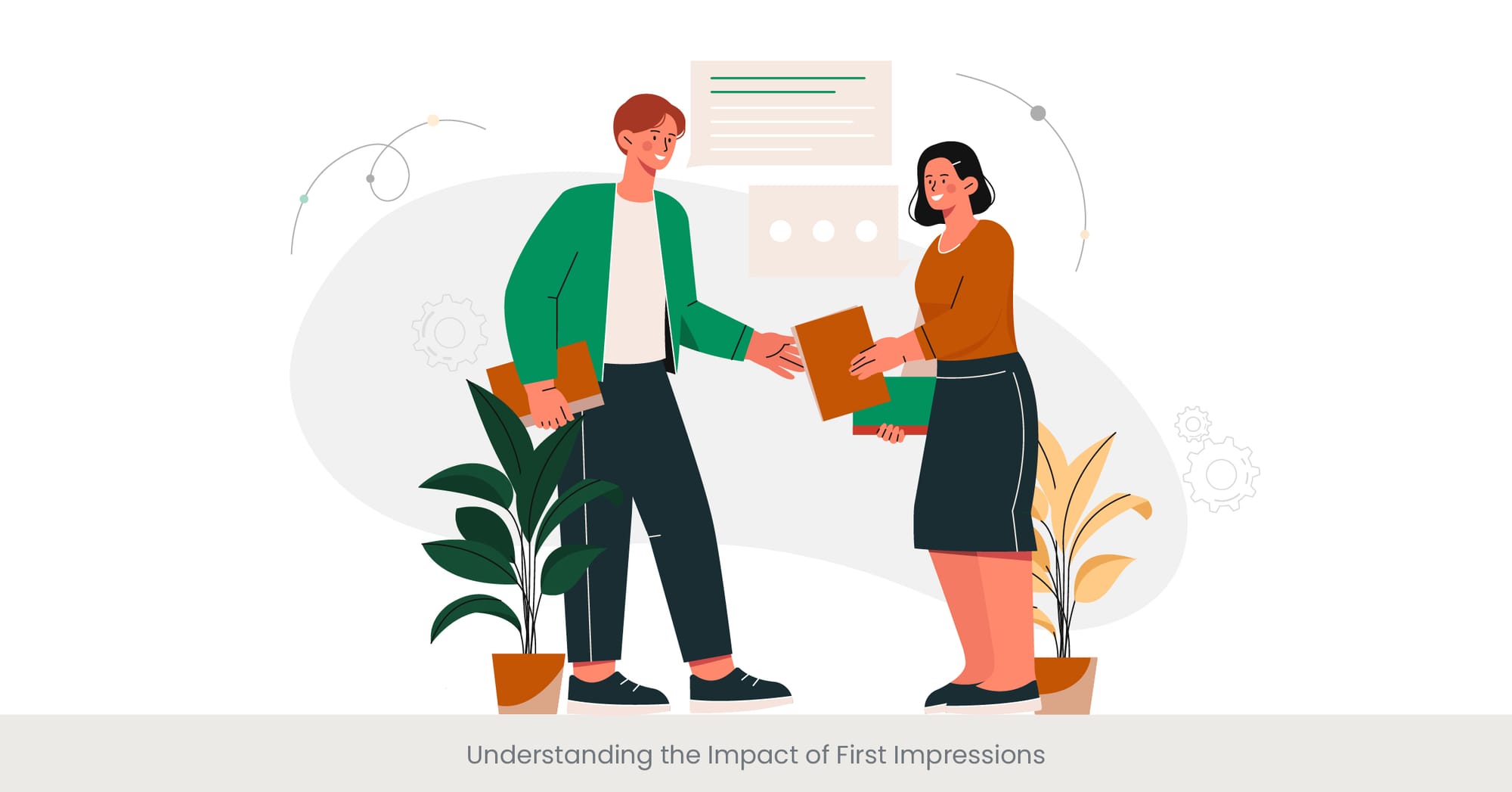
Introduction to the Impact of First Impressions
The axiom "You never get a second chance to make a first impression" holds an indisputable truth, especially in the context of recruitment. First impressions in recruitment are not solely based on the direct interactions between candidates and recruiters but are significantly influenced by the presentation of the recruitment process itself. This encompasses the visual and structural design of recruitment materials, from job descriptions to Google Slides presentations used during interviews. A well-designed recruitment presentation not only conveys the professional standards of an organization but also its values, culture, and the essence of its brand. By strategically leveraging design, companies can ensure that their first point of contact with potential candidates sets a positive tone for the entire recruitment journey.
Background: The Significance of Design in Recruitment
The interplay between design and recruitment is deeply rooted in the principles of visual communication and branding. A recruitment strategy that incorporates thoughtful design can effectively communicate a company's mission and culture, resonate with the desired audience, and ultimately attract the right talent. Elements such as color, typography, and layout in job postings, PowerPoint templates, and recruitment presentations work together to create a cohesive and appealing narrative. This narrative is crucial in not just attracting candidates but in making the recruitment process memorable and engaging. In a competitive job market, where companies vie for the attention of the best talents, the design of recruitment materials becomes a key differentiator.
Real-World Application and Current Trends
In the digital age, the recruitment process often begins long before a candidate submits their application. Websites, social media profiles, and online job listings act as the initial touchpoints. Companies like Google have set benchmarks by integrating their brand's design language into their recruitment presentations and strategies, making use of Google Slides to create visually appealing and informative job descriptions and company overviews. These materials not only provide clear calls to action but also give insights into the company's culture, expectations, and the benefits of joining the team. The trend towards more dynamic and design-focused recruitment materials is also evident in the increasing use of video content, interactive slides, and virtual reality experiences to simulate the work environment or illustrate the company's day-to-day operations.
External References and Statistics
According to a study by The Undercover Recruiter, visual design elements in recruitment materials significantly impact a candidate's perception of a company. For example, 78% of candidates state that the design of a company's recruitment material affects their decision to apply for a position. Furthermore, a survey by LinkedIn highlighted that 59% of candidates consider a company's online presence, including the design and presentation of its recruitment process, before applying. These statistics underscore the critical role of design in not only attracting candidates but also in fostering a positive and engaging candidate experience.
Online Hiring Strategy Decks
Creating effective online hiring strategy decks helps HR teams streamline the recruitment process by defining clear goals, target candidates, and digital channels to reach them. These decks can be used to align internal teams and improve overall recruitment efforts, ensuring that the best candidates are selected in a timely manner.
Looking to transform your recruitment strategy? Let INK PPT help you design visually compelling and professional recruitment presentations that make a lasting impression. Contact us today to elevate your recruitment process.
The Interplay Between Design and Brand Perception
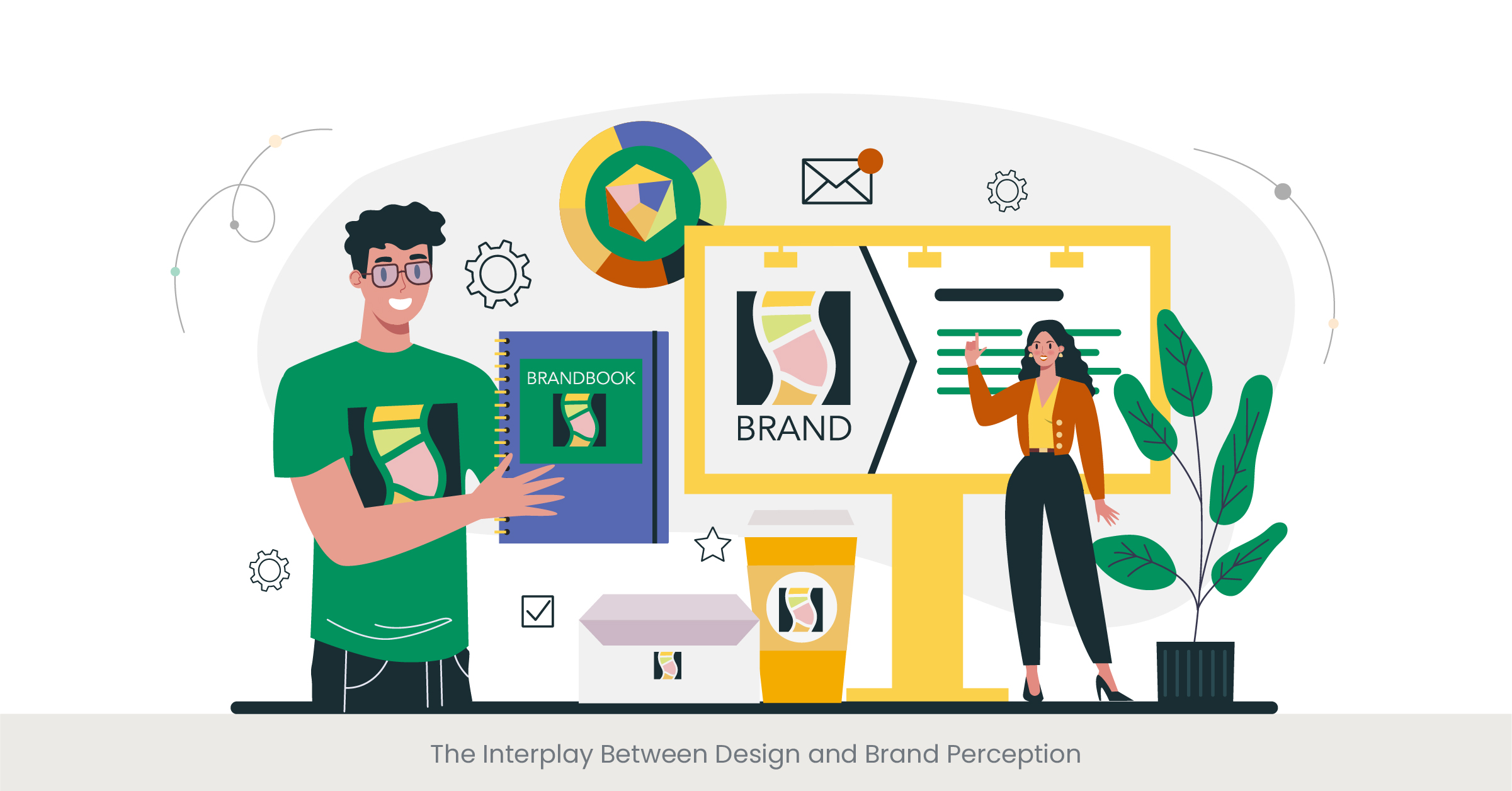
Introduction to Design and Brand Perception
The symbiotic relationship between design and brand perception in recruitment cannot be overstated. Design acts as a silent ambassador of a brand's values, ethos, and professionalism. In the recruitment arena, the strategic use of design in presentations, job descriptions, and company overviews can profoundly influence potential candidates' perceptions. A well-crafted recruitment presentation, utilizing tools like Google Slides and PowerPoint templates, serves not only as a medium to convey necessary information but as a canvas to showcase the company's brand identity, culture, and values. This careful orchestration of design elements plays a pivotal role in building a compelling brand image that resonates with potential candidates and encourages them to envision a future within the company.
Background on Brand Perception in Recruitment
Brand perception, in the context of recruitment, extends beyond mere recognition. It encompasses the collective feelings, beliefs, and expectations individuals have about a company as a potential employer. This perception is influenced by every interaction, whether through direct communication, social media, or the visual and textual language used in recruitment materials. Companies that master the art of integrating their brand identity into the recruitment process, using consistent color schemes, typography, and messaging across all materials, stand out. They not only attract candidates but also align potential recruits with the company’s culture and values from the outset. This strategic alignment helps in attracting not just any talent, but the right talent that is a good fit for the company.
Real-World Examples and Trends
Innovative companies are increasingly adopting a design-centric approach to recruitment to enhance their brand perception. For example, Airbnb’s recruitment strategy includes a meticulously designed candidate experience that mirrors its brand’s emphasis on belonging and unique experiences. From visually appealing job descriptions to immersive interview experiences that utilize dynamic slide presentations, Airbnb showcases its commitment to creativity and innovation, setting a high standard for candidate engagement. Similarly, Dropbox has leveraged its brand's design ethos in its recruitment process by creating a unique interview experience that reflects the company's innovative and user-centric approach. These examples illustrate how integrating brand identity into the recruitment design not only elevates a company’s image but also attracts candidates who are aligned with the brand’s values and vision.
External References and Statistics
A survey conducted by Glassdoor reveals that 84% of job seekers consider the reputation of a company as an employer to be important when making their decision to apply for a job. Additionally, a study by CareerBuilder found that job postings with videos receive a 34% greater application rate, underscoring the impact of engaging and well-designed recruitment materials on attracting candidates. These statistics highlight the significance of design in shaping brand perception and its direct influence on a company’s ability to attract qualified candidates.
Want to communicate your company's mission through powerful visuals? Let INK PPT design a recruitment experience that resonates with the right talent. Get in touch to learn more about our design services.
Visual Communication: Conveying Company Values and Missions
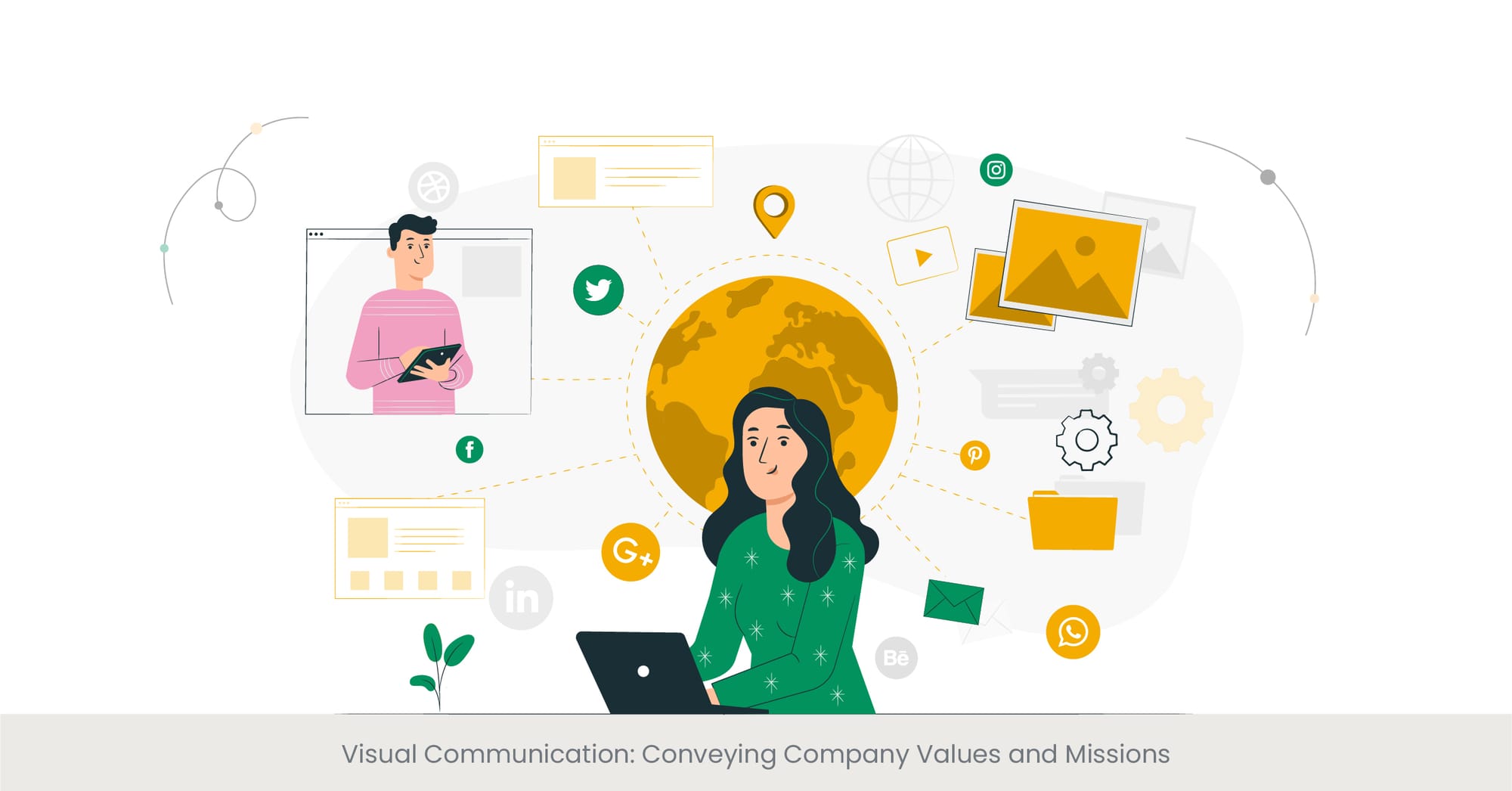
Introduction to Visual Communication in Recruitment
In the realm of recruitment, visual communication serves as a powerful tool to convey a company's values and mission to potential candidates. The strategic use of design elements such as color, imagery, and typography in recruitment materials can communicate more than just the details of a job position; they can impart a sense of the company's culture, ethos, and priorities. Effective visual communication in recruitment presentations, whether through PowerPoint templates or Google Slides, enables companies to create a compelling narrative that aligns with their brand identity and resonates with the right talent. This alignment ensures that candidates are not only informed about the job but are also inspired by the possibility of contributing to a mission they believe in.
Background on the Role of Visual Communication
Visual communication in recruitment transcends traditional boundaries, offering a medium to express what words alone cannot. It encompasses the entirety of the experience a candidate has with the company's recruitment materials, from the initial job advertisement to the final recruitment presentation. The choice of colors, for instance, can evoke specific emotions and associations—blue can convey trust and stability, while green might symbolize growth and innovation. Similarly, typography can influence the readability and mood of the presented information. By carefully selecting these elements, companies can ensure their recruitment materials accurately reflect their mission and values, thereby attracting candidates who share similar ideals.
Illustrative Examples and Current Trends
Companies leading in the sphere of recruitment understand the importance of leveraging visual communication to attract the right candidates. For example, Tesla utilizes bold imagery and a clean, futuristic design in its recruitment materials to reflect its mission of accelerating the world's transition to sustainable energy. This clear visual messaging helps attract candidates who are passionate about innovation and environmental sustainability. Another example is the tech giant, Google, known for its colorful and playful design approach, which mirrors its values of creativity and collaboration. By consistently applying these design principles across all its recruitment materials, Google effectively communicates its culture and mission, attracting like-minded individuals.
External References and Statistics
Research underscores the impact of visual communication on recruitment success. A study by the Aberdeen Group found that companies with strong employer branding (which includes visual design) are 3.5 times more likely to attract top talent. Moreover, LinkedIn’s Global Recruiting Trends report highlights that 80% of leaders in talent acquisition believe employer branding has a significant impact on the ability to hire great talent, with visual design playing a key role in shaping that brand. These insights confirm the critical importance of visual communication in not only conveying a company’s values and mission but also in attracting and engaging potential candidates.
The Psychology of Color and Typography in Recruitment
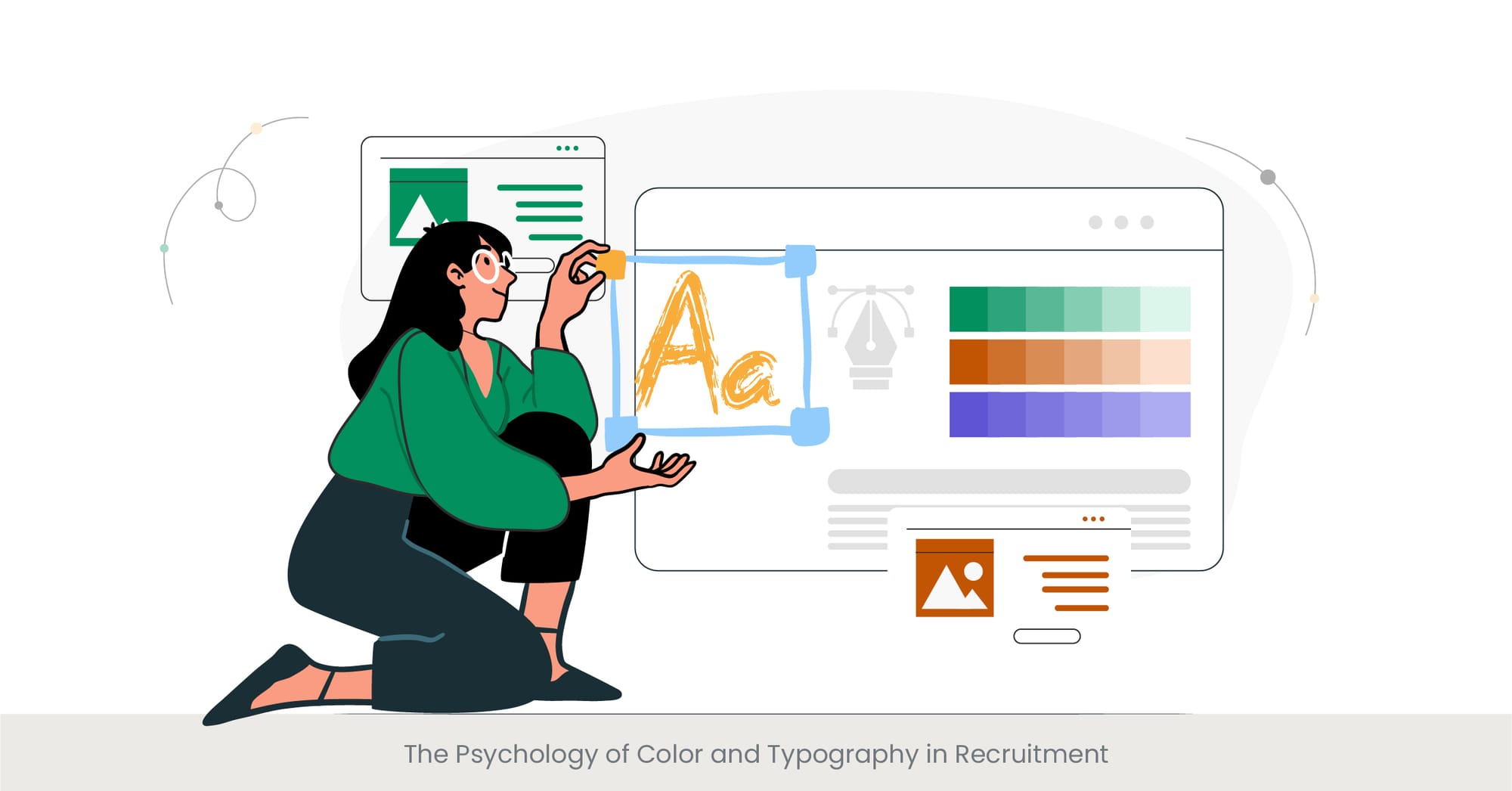
Understanding Color and Typography in Recruitment
The psychology behind color and typography plays a pivotal role in the recruitment process, significantly influencing candidate perceptions and decisions. Colors and fonts are not mere embellishments; they are strategic tools that convey mood, tone, and corporate values. For instance, the use of blue in recruitment presentations and Google Slides can instill a sense of trust and security, while creative typography can make a brand seem more approachable and innovative. When used thoughtfully, these elements can create an emotional resonance with potential candidates, aligning their perception with the company’s desired brand image and making the recruitment process more effective and memorable.
The Impact of Color and Typography on Candidate Behavior
Research in color psychology suggests that different colors can evoke specific emotional responses and behaviors. For example, red can capture attention and stimulate action but may also raise feelings of urgency or caution. Similarly, typography influences readability and the overall aesthetic appeal of recruitment materials, affecting engagement levels. A study published in the Journal of Applied Psychology highlighted that recruitment advertisements with high readability and aesthetic appeal significantly increased job attractiveness to potential candidates. Therefore, the strategic use of color and typography not only enhances the visual appeal of recruitment materials but also subtly guides candidate behavior towards desired outcomes.
Real-World Applications and Trends
Leading companies are increasingly recognizing the importance of color and typography in their recruitment strategies. For example, a tech startup might use vibrant colors and modern fonts to appeal to innovative and dynamic candidates, while a law firm may opt for more subdued colors and traditional typography to convey professionalism and stability. Google, with its colorful logo and user-friendly design aesthetics, employs a similar approach in its recruitment presentations and job descriptions, effectively communicating its vibrant and innovative company culture. These examples demonstrate how the thoughtful application of color and typography can enhance brand perception and attract candidates who are a good fit for the company’s culture and values.
External References and Statistics
According to a survey by CareerBuilder, 78% of candidates believe the look and feel of a company's recruitment materials is indicative of its corporate culture. Furthermore, a study from the University of Winnipeg found that 90% of snap judgments made about products (or, by extension, companies) can be based on color alone. These insights underscore the significance of leveraging the psychology of color and typography in recruitment materials to influence candidate perceptions and behaviors positively.
Digital Recruitment Presentations
In today’s tech-driven world, digital recruitment presentations have become essential for engaging with candidates remotely. These presentations should highlight the company’s digital presence, tools, and remote work capabilities. Ensuring the use of visually stimulating content will capture candidate interest and promote the organization’s innovation in the hiring process.
Harness the power of color and typography to make your recruitment materials stand out. Work with INK PPT to create designs that engage and inspire your ideal candidates.
Navigating the Balance: Professionalism vs. Creativity
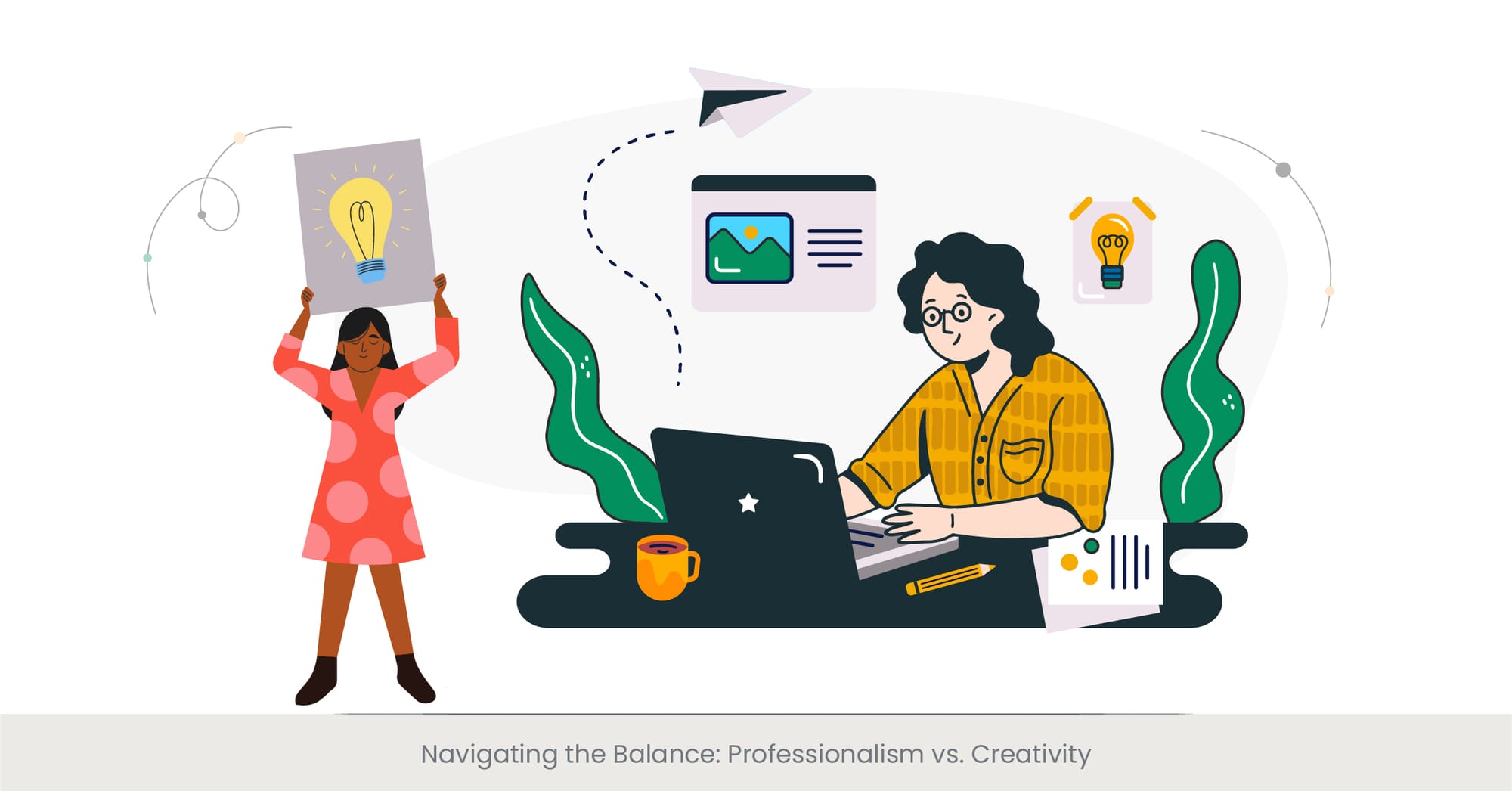
Striking the Perfect Balance
In the recruitment landscape, finding the right balance between professionalism and creativity in design is crucial. This balance is key to attracting a diverse pool of candidates while maintaining the company’s brand integrity. A recruitment presentation that leans too much towards creativity might risk undermining the company's professional image, whereas an overly formal approach could fail to engage potential candidates effectively. The challenge lies in crafting a recruitment strategy that embodies the company’s core values and culture through a blend of traditional and innovative design elements. This equilibrium ensures that the recruitment process not only attracts candidates but also resonates with them on a personal level, indicating what it's truly like to be part of the organization.
Background on Professionalism and Creativity in Design
The concepts of professionalism and creativity in design are not mutually exclusive but rather complementary when executed correctly. Professionalism in recruitment materials, such as job descriptions and company overviews, conveys a sense of reliability and trustworthiness. At the same time, creativity showcases the company’s innovation and forward-thinking approach. Utilizing tools like Google Slides and PowerPoint templates allows for flexibility in how information is presented, enabling the inclusion of creative elements such as interactive slides or embedded videos without compromising the material's overall professionalism. This approach can significantly enhance the candidate's engagement and perception of the company.
Illustrative Examples and Trends
Companies like Adobe and Pixar have successfully navigated this balance. Adobe, known for its creative software suite, employs a clean, professional design in its recruitment materials, complemented by creative elements that reflect its innovative culture. Similarly, Pixar's recruitment strategy uses storytelling and character-driven narratives to engage potential candidates, while maintaining a level of professionalism that aligns with its reputation as a leading animation studio. These examples demonstrate that it is possible to present a company as both a professional and creative workplace, thereby attracting a wide range of candidates who are eager to contribute to its success.
External References and Statistics
A LinkedIn study revealed that 72% of recruiting leaders worldwide agree that employer brand significantly impacts hiring. Additionally, a survey by Glassdoor indicated that 76% of job seekers want details on what makes a company an attractive place to work. These statistics highlight the importance of incorporating both professionalism and creativity in recruitment design to not only attract candidates but also to provide them with a clear and engaging understanding of the company's culture and values.
Tailoring Design to Different Audiences
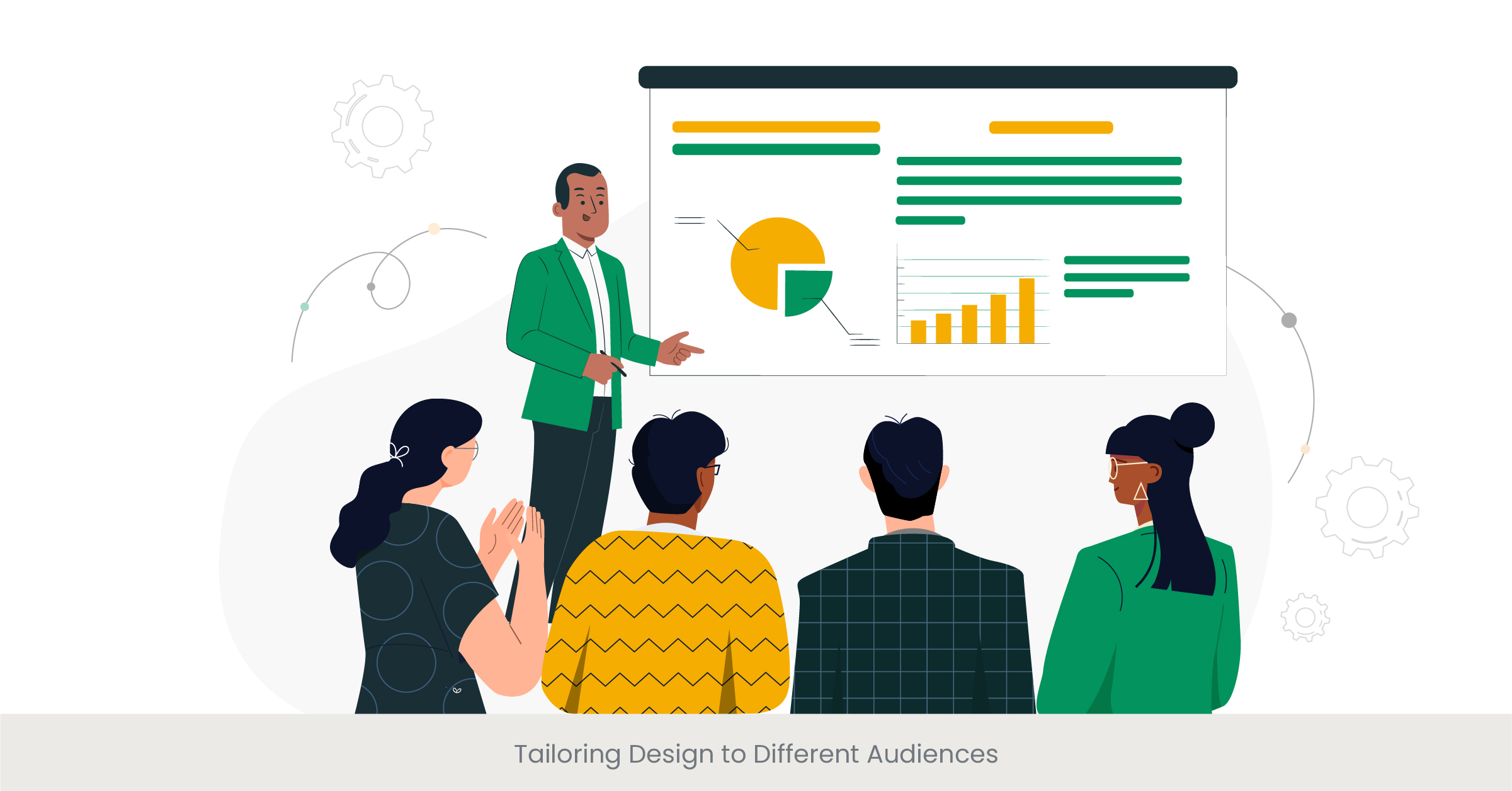
Customizing Recruitment Strategies for Diverse Audiences
The effectiveness of a recruitment strategy significantly hinges on its ability to resonate with its intended audience. Tailoring the design of recruitment materials to suit different audiences is not just about aesthetic appeal but about creating a connection that speaks directly to the aspirations, values, and professional goals of potential candidates. This customization can involve varying the presentation's design elements, such as color schemes, imagery, and language, to align with the expectations and preferences of different demographic segments. Whether targeting fresh graduates or seasoned professionals, the adaptability of the presentation for recruitment strategy and design plays a crucial role in attracting and engaging the right talent.
The Importance of Audience Segmentation in Recruitment Design
Understanding the demographics, career aspirations, and values of your target audience is essential for effective recruitment design. For example, younger audiences may prefer more vibrant colors and dynamic layouts, reflecting their energy and innovation, while more experienced professionals might appreciate a design that emphasizes stability, growth opportunities, and the company's legacy. Tools like Google Slides and PowerPoint templates offer the flexibility to adjust these elements seamlessly, allowing for a customized approach to each audience segment. By segmenting the audience and tailoring the design accordingly, companies can significantly enhance the effectiveness of their recruitment strategy.
Examples of Effective Audience-Centric Design
A notable example of tailored recruitment design is seen in tech companies like Spotify and Netflix, which employ bold and innovative designs to attract creative and tech-savvy candidates. These companies use engaging visuals, interactive content, and informal language in their job descriptions and recruitment presentations to appeal to their target demographic. In contrast, financial institutions like J.P. Morgan adopt a more conservative design approach, with a focus on professionalism and growth opportunities, to attract candidates looking for stability and career development. These examples illustrate how adjusting design elements to match audience expectations can greatly improve recruitment outcomes.
External References and Statistics
According to a report by the Recruitment & Employment Confederation, 34% of job seekers stated that personalized communication significantly influenced their decision to apply for a position. Additionally, a study by Deloitte highlighted that companies with high-impact recruitment strategies are 3 times more likely to succeed in attracting top talent. These findings underscore the importance of tailoring recruitment design to different audiences as a key strategy for engaging and attracting diverse candidates effectively.
Talent Acquisition Presentations
A successful hiring process often begins with compelling talent acquisition presentations that showcase the company’s vision, values, and growth opportunities. These presentations can help HR teams attract top talent by clearly communicating what sets your organization apart. Personalizing the content to address candidate needs will increase your chances of hiring the best.
Case Studies: Design-Driven Recruitment Success Stories

Introduction to Design-Driven Recruitment Success
The impact of well-executed design in recruitment strategies is best illustrated through real-world success stories. Companies that have prioritized design in their recruitment processes often report higher engagement rates, a better quality of candidate applications, and improved brand perception among potential recruits. These case studies not only serve as a testament to the power of design but also provide valuable insights and inspiration for organizations looking to enhance their own recruitment strategies.
Background on the Importance of Design in Recruitment
Incorporating design into recruitment strategy goes beyond creating visually appealing materials; it involves crafting experiences that reflect the company's culture, values, and aspirations. This strategic integration of design helps in storytelling, making the company more relatable and desirable to potential candidates. By leveraging elements like color, typography, and layout, companies can convey their unique employer brand proposition in a way that resonates with their target audience, thereby attracting candidates who are not just qualified but also a cultural fit.
Illustrative Success Stories
One notable example is Airbnb, which redesigned its careers page template and recruitment materials to reflect its brand identity of belonging and inclusivity. The use of authentic employee stories, interactive design elements, and a clear depiction of company values led to a significant increase in qualified applicants. Similarly, LinkedIn’s use of personalized recruitment presentations and videos showcasing employee testimonials and day-in-the-life scenarios has enhanced its employer brand, making it one of the most sought-after companies to work for. These examples highlight how a thoughtful design approach can transform the recruitment process, making it more effective and aligned with the company's overall brand strategy.
Want to see similar success with your recruitment process? Let's discuss how we can tailor design strategies to fit your company's unique needs.
External References and Statistics
A survey by LinkedIn revealed that companies with strong employer branding (which includes design and aesthetic appeal) see a 50% decrease in cost per hire and a 28% reduction in employee turnover. Additionally, a study by the Design Management Institute found that design-driven companies outperformed the S&P Index by 219% over ten years, underscoring the broad impact of design on all aspects of organizational success, including recruitment. These statistics demonstrate the tangible benefits of incorporating design into recruitment strategies, from enhancing the candidate experience to improving the company's bottom line.
Future Trends: The Evolving Landscape of Recruitment Design

Introduction to Emerging Trends in Recruitment Design
The landscape of recruitment design is constantly evolving, driven by technological advancements, changing candidate expectations, business will, and new insights into what attracts top talent. As we look to the future, several key trends are emerging that promise to reshape how companies design their recruitment strategies. These trends not only enhance the candidate experience but also enable organizations to communicate their values, culture, and opportunities in more engaging and innovative ways.
Technological Innovations and Their Impact
One of the most significant trends is the integration of artificial intelligence (AI) and machine learning into the design of recruitment materials. AI can personalize the recruitment experience for candidates by tailoring presentations and job descriptions to their interests and background, using data analytics to optimize design elements for engagement. Additionally, the rise of virtual reality (VR) and augmented reality (AR) offers new possibilities for immersive job previews, allowing candidates to experience a day in the life at a company or explore the office environment remotely. These technological innovations are making recruitment materials more interactive, engaging, and informative, providing a competitive edge in attracting top talent.
The Shift Towards Authenticity and Personalization
Another emerging trend is the focus on authenticity and personalization in recruitment design. Candidates are increasingly seeking transparency and genuine insights into company culture and values. This shift demands recruitment materials that go beyond glossy presentations to include real employee stories, behind-the-scenes glimpses, and user-generated content. Personalization, facilitated by data analytics, enables companies to tailor their messages to individual candidates, making communications more relevant and appealing. This trend towards authenticity and personalization is driving a more candidate-centric approach in recruitment design, fostering deeper connections between companies and potential employees.
Create authentic recruitment experiences that resonate with top talent. Let’s craft personalized, design-driven materials for your brand.
Sustainability and Social Responsibility in Design
As environmental and social responsibility become more important to candidates, companies are also incorporating these themes into their recruitment design. Sustainable design practices, such as digital-only materials and eco-friendly printing options, reflect a company’s commitment to sustainability. Furthermore, showcasing initiatives and policies related to diversity, equity, and inclusion in recruitment materials is becoming crucial for attracting socially conscious candidates. This trend underscores the growing importance of aligning recruitment strategies with broader corporate social responsibility goals to appeal to the values of prospective employees.
External References and Insights
According to a LinkedIn Global Talent Trends report, 76% of job seekers consider a company’s employer brand before even applying for a job. A survey by Deloitte highlights that 80% of millennials look for people and culture fit with employers, followed by career potential. These insights emphasize the need for recruitment designs that are not only technologically advanced and interactive but also authentic, personalized, and socially responsible. As companies navigate these trends, the design of recruitment materials will continue to play a pivotal role in attracting and retaining top talent.
Align your recruitment strategy with your sustainability goals. Contact us to create eco-friendly and socially responsible recruitment materials.
Integrating Feedback: Continuous Improvement in Design Strategy

Embracing Feedback for Recruitment Design Evolution
The recruitment landscape is dynamic, with candidate preferences and expectations evolving constantly. Integrating feedback into the company overview recruitment design strategy is not just beneficial; it's essential for continuous improvement and staying competitive. Feedback from candidates, hiring managers, and recruiters offers invaluable insights into the effectiveness of design elements in recruitment materials. This ongoing loop of feedback and refinement ensures that recruitment strategies remain aligned with organizational goals, brand identity, and the ever-changing job market.
The Process of Gathering and Implementing Feedback
Feedback can be collected through various channels, including post-interview surveys, social media interactions, and analytics from the company's career site. Advanced tools and platforms, such as Google Analytics, offer detailed insights into how potential candidates interact with online recruitment materials, identifying what captures their attention and where improvements are needed. Implementing this feedback may involve redesigning templates, updating color schemes, or rethinking the content layout in presentations and job descriptions. The key is to view feedback not as criticism but as a valuable resource for enhancing the candidate experience and the effectiveness of recruitment efforts.
Real-World Examples of Feedback-Driven Design Improvements
Companies that have successfully integrated feedback into their recruitment design process often report higher engagement rates and improved application quality. For instance, a multinational corporation revamped its recruitment presentation format based on candidate feedback, resulting in a more engaging and interactive experience that led to a 20% increase in qualified applications. Similarly, by analyzing feedback on its careers page, a tech company identified opportunities to better highlight its company culture through videos and employee testimonials, significantly improving its employer brand perception.
External References and Statistics
According to a report by the IBM Smarter Workforce Institute, organizations that use feedback to improve their recruitment processes are twice as likely to improve their talent acquisition outcomes and three times as likely to reduce their hiring costs. Furthermore, a study by the Talent Board found that candidates who were satisfied with their application process were 38% more likely to accept a job offer. These statistics underscore the importance of integrating feedback into the recruitment design strategy, highlighting its impact on both the efficiency of the recruitment process and the overall candidate experience.
Ethics in Design: Ensuring Authenticity and Transparency

Upholding Ethical Standards in Recruitment Design
In the domain of recruitment, the ethical use of design extends beyond aesthetic appeal to encompass the principles of authenticity and transparency. Ethical design practices ensure that recruitment materials accurately reflect the company's culture, values, and the realities of job roles and expectations. This approach fosters trust and credibility with potential candidates, avoiding misleading representations that can lead to disillusionment and turnover. Upholding ethical standards in design not only enhances the candidate experience but also supports the organization's long-term recruitment and retention goals.
The Importance of Authenticity and Transparency
Authenticity in design means providing a true-to-life representation of the company and its culture, avoiding embellishment or omission of critical information. Transparency involves clear communication about job roles, expectations, and the recruitment process. Together, these principles guide the creation of recruitment materials that offer an honest and clear view of what candidates can expect. This ethical approach to design helps attract candidates who are a good fit for the company, reducing the risk of mismatches and fostering a positive employer brand.
Implementing Ethical Design Practices
Implementing ethical design practices involves several key strategies, including the use of real employee testimonials, accurate job descriptions, and open communication about the recruitment process. For example, incorporating employee-generated content in recruitment presentations can provide candidates with genuine insights into the company's culture. Additionally, ensuring job descriptions and recruitment materials are clear, comprehensive, and free of jargon contributes to an ethical and transparent recruitment process that respects candidates' rights to informed decision-making.
External References and Perspectives
A survey by the Corporate Responsibility Magazine found that 75% of job seekers would not take a job with a company that had a bad reputation, even if unemployed. This statistic underscores the importance of ethical design practices in building a positive employer brand. Furthermore, a study by LinkedIn emphasizes that companies with a recruitment budget and a strong employer brand see a 50% reduction in cost per hire, highlighting the tangible benefits of ethical design practices in recruitment.
New Hire Orientation Slides
When onboarding new employees, new hire orientation slides play a crucial role in setting expectations and introducing company culture. These slides should be engaging, visually appealing, and cover essential information like company policies, team structure, and key resources. Well-designed orientation slides help new hires feel welcome and informed from day one.
Enhance your new hire onboarding experience with engaging orientation slides. Let’s design impactful materials that welcome and inform your new team members.
FAQs:
What are 5 recruitment strategies?
Leveraging social media for talent acquisition.
Implementing employee referral programs.
Utilizing job fairs and recruitment events.
Engaging with staffing agencies for specialized roles.
Developing a strong employer brand through effective design and communicatio
What is included in a recruitment strategy?
A detailed job description, a clear outline of the recruitment process, strategies for candidate engagement and assessment, salary, and a plan for integrating new hires into the company culture.
How do you write a strategic recruitment plan?
Identify, describe the position requirements, define your target candidate audience, develop a sourcing strategy, design engaging recruitment materials, and establish a clear selection and onboarding process.
How can I be more strategic in recruitment?
Focus on building a strong employer brand, leverage data analytics for decision-making, tailor your approach to different talent pools, and continuously refine your strategies based on feedback.
What is a recruitment presentation?
A recruitment presentation is a visually engaging way to communicate a company's culture, values, job opportunities, and explain what makes it a desirable employer to potential candidates.
What is the 7 stage of recruitment?
Preparation, sourcing, screening, interviewing, assessment, selection, and onboarding.
What are the three C's of recruitment?
Culture, capability, and compatibility are key considerations in assessing whether a candidate is a good fit for a position and the organization structure.
How do recruiters present candidates?
Recruiters often present candidates to hiring managers through detailed profiles that highlight their skills, experience, cultural fit, and potential contributions to the team and company.
Final Reflections:
The critical role of design in recruitment cannot be overstated. As we've explored, effective design not only enhances the visual appeal of recruitment materials but also significantly impacts a company's ability to attract and retain top talent. By conveying a company's values, culture, and mission through thoughtful design, organizations can create a compelling narrative that resonates with potential candidates. The future of recruitment lies in leveraging design to build authentic connections, embody corporate identity, and adapt to the evolving expectations of the job market. As companies strive to navigate the competitive landscape of talent acquisition, the integration of design principles into recruitment strategies emerges as a key differentiator, setting the stage for long-term success in attracting the right talent.



%20(1).jpg)
%20(1).jpg)


